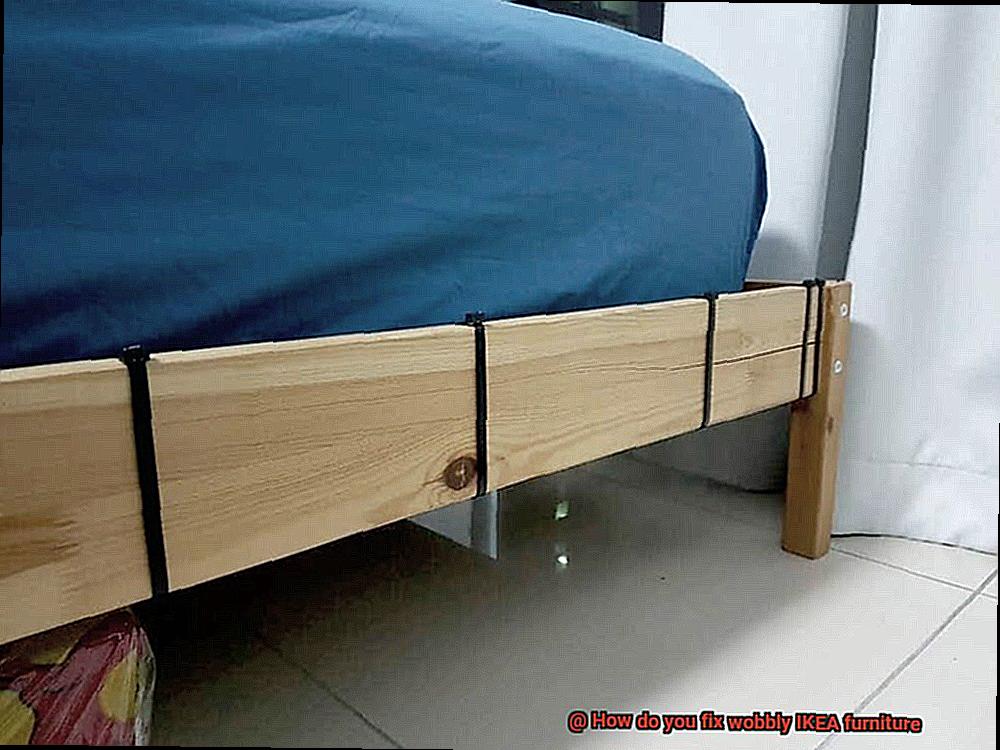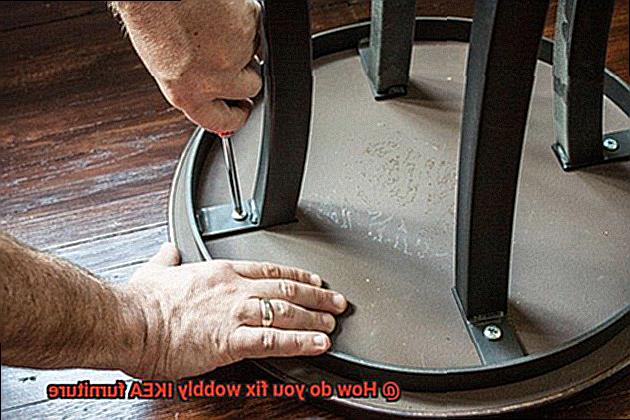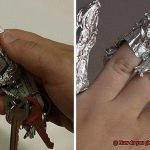We’ve all been there – you finally finish putting together that sleek IKEA piece, only to discover it’s wobbling like a tipsy penguin. Ugh, talk about frustrating. But fear not, my fellow IKEA aficionados, because today we’re diving headfirst into the magical world of fixing wobbly furniture from the Swedish powerhouse. Armed with a few nifty tricks and a sprinkle of patience, you’ll not only banish the wobble but also ensure your beloved IKEA gem stands tall and proud for years to come. So roll up those sleeves and prepare to bid adieu to those shaky moments once and for all.
Identifying the Source of the Problem
Contents
We’ve all experienced the frustration of assembling our brand new IKEA furniture, only to find that it wobbles and feels unstable. But fear not. In this article, we will guide you through the process of identifying the source of the problem and provide effective solutions to fix your wobbly IKEA furniture. So grab your tools and let’s get started.
Common Causes of Wobbliness:
- Improper Assembly: Rushing through the assembly process or not following the instructions carefully can result in loose connections and unstable furniture.
- Quality of Materials: While IKEA furniture is known for its affordability, some pieces may be less sturdy due to cheaper materials or construction methods.
- Wear and Tear: Regular use and movement of furniture can loosen screws and fasteners over time, leading to wobbliness.
Thorough Inspection:
To accurately identify the source of the problem, conduct a thorough inspection:
- Check all connections and joints for signs of looseness or instability, paying attention to screws and fasteners.
- Examine the overall structure for unbalanced or uneven areas, which could indicate a problem with the frame or support system.
- Disassemble parts if necessary to get a closer look at the internal structure.
Effective Solutions:
- Tighten Loose Screws: Use a screwdriver or Allen wrench to securely tighten all screws, ensuring stability.
- Stabilize Legs: Prevent sliding by using adhesive pads or felt pads on the bottom of legs, or replace legs with sturdier options.
- Reinforce Shelves or Drawers: Add additional support brackets or braces to reinforce their structure.
- Add Weight: Provide added stability by placing heavy objects or books on the bottom shelves or inside drawers.
- Disassemble and Reinforce: If needed, disassemble the furniture and reassemble it with additional reinforcements using wood glue, brackets, or other hardware.
Tightening Loose Screws
We’ve all been there, my friends. But fear not, because today I’m going to reveal the secret to tightening those loose screws and restoring stability to your furniture kingdom.
One of the most common culprits behind wobbliness in IKEA furniture is loose screws. You see, IKEA furniture is designed to be assembled by us, the consumers. And sometimes, in the midst of our excitement or frustration, we may not tighten those screws as securely as we should. Over time, this can lead to a wobbly disaster waiting to happen.
So, how do we fix this? It’s simple really. First, give your furniture a gentle shake or wiggle to identify the loose screw(s). Once you’ve located the culprit, clear away any items or accessories that may obstruct your access to the screw(s). Cushions, shelves, and other components can get in the way, so make sure they’re out of the path.
Now comes the fun part – tightening those screws. Get yourself an appropriate screwdriver or Allen wrench (depending on the type of screws your furniture has). Firmly place it into the screw head and turn it clockwise (righty-tighty) until you feel resistance. Don’t be afraid to use a bit of force, but be careful not to overtighten and strip the screw or damage the material.
If you find that a screw keeps coming loose despite your best efforts, it might be time to bring in some reinforcements. Apply a small amount of wood glue or adhesive to the threads of the screw before tightening. This will create a stronger bond and help prevent future loosening.
But wait, there’s more. Don’t just focus on that one pesky screw. Take a few extra minutes to inspect the rest of your furniture. Check the legs, support brackets, and joints for any other loose screws that may be hiding in plain sight. This proactive approach will save you from future headaches and potential furniture disasters.
Stabilizing Unstable Legs
Imagine sitting down on your favorite IKEA chair or table, only to feel it wobble and sway beneath you. Don’t worry, because in this guide, we will show you how to regain the stability you deserve. From tightening screws to reinforcing with glue, brace yourself for a world of stable furniture.
Identify the Cause:
To tackle unstable legs, first identify the culprit behind the wobbliness. Loose screws? Damaged joints? An uneven floor surface? Or perhaps, an incorrect assembly? Take a closer look and pinpoint the source of instability.
Tighten Loose Screws:
If loose screws are to blame, grab your trusty screwdriver or Allen wrench and tighten them up. But beware, overtightening can strip holes or damage screws. Exercise caution while restoring stability.
Reinforce with Glue or Adhesive:
For damaged or worn-out joints, unleash the power of wood glue or epoxy adhesive. Apply them to the weakened areas and clamp them tight until dry. Witness the transformation as the connection strengthens and wobbling becomes history.
Add Furniture Braces or Brackets:
Let’s embrace the power of metal. Consider using furniture braces or brackets for extra support and stability. Attach these sturdy reinforcements to both the legs and main structure to fortify weak areas and eliminate wobbling for good.

Level Out Uneven Surfaces:
Unlevel floors got you down? Fear not. Equip your furniture with furniture pads or felt sliders under its legs. These simple additions will level out your furniture and restore balance in the face of unevenness.
Additional Modifications for Long-Term Stability:
Some IKEA furniture may require extra modifications for long-term stability. Brace yourself (and your furniture) by adding support beams, reinforcing weak areas with additional hardware, or even replacing certain components with sturdier alternatives. Assess the construction and make the necessary adjustments for lasting stability.

Regular Maintenance and Inspections:
Prevention is key. Make regular inspections and maintenance a habit. Check for loose screws or joints, and address any issues promptly to avoid future instability. Keep your furniture in top-notch condition with a little TLC.
Seek Professional Help:
If all else fails or if you’re unsure about DIY fixes, call in the experts. Furniture repair specialists or carpenters will assess the situation and provide appropriate solutions. Let them work their magic, ensuring your IKEA furniture remains stable and sturdy.
Reinforcing Shelves and Drawers
IKEA furniture is renowned for its affordability and stylish design. However, over time, shelves and drawers can become wobbly, causing frustration and instability. Fear not. With a little DIY magic, you can reinforce these components and restore stability to your favorite IKEA pieces. In this article, we will provide you with step-by-step instructions on how to reinforce shelves and drawers using glue, brackets, adhesive strips, and regular maintenance.
Step 1: Assess the Damage
To begin, remove all items from the shelf or drawer to avoid any accidental damage. Inspect for loose connections, damaged screws, or nails that may need tightening.
Step 2: Glue it Up
If tightening the screws doesn’t solve the wobbling issue, it’s time to bring out the glue. Apply wood glue to loose joints or connections, ensuring a thin and even layer. Press the parts together firmly and wipe off excess glue with a damp cloth.
Step 3: Extra Support for Shelves
If the shelf still wobbles, consider adding L-brackets at the corners where the shelf meets the side panels. These metal brackets provide additional stability when secured with screws.
Step 4: Enhancing Drawer Stability
For wobbly drawers, carefully remove them from their housing. Inspect the drawer slides for wear or damage and replace them if necessary with compatible ones from IKEA or a hardware store.
Step 5: Reinforce with Adhesive Strips
If replacing the drawer slides doesn’t fully resolve the wobbling issue, use adhesive strips or double-sided tape on the underside of the drawer. These strips provide extra grip and stability when the drawer is closed.
Step 6: Regular Maintenance

To prevent future wobbling, perform regular maintenance on your IKEA furniture. Check for loose screws, damaged parts, or signs of wear and tear. Tighten any loose screws promptly and address any issues immediately.
Step 7: Seek Professional Help
If you’re unsure about DIY repairs, seek professional assistance or contact IKEA’s customer service team for expert advice.
Adding Weight to Furniture
If you have ever assembled IKEA furniture, you may be familiar with the frustration of encountering wobbly pieces. Fortunately, there are simple and effective methods to stabilize your furniture, and adding weight is one of them. In this guide, we will explore various ways to add weight to your furniture, ensuring long-lasting stability.
One popular option for adding weight is using glue. Glue provides a strong and durable bond that reinforces joints and prevents wobbling. It is a cost-effective solution, as a small amount goes a long way in securing your furniture. With its versatility, glue can be used on different materials like wood or metal, making it suitable for various types of IKEA furniture.
However, it’s essential to consider the downsides of using glue. Once applied, it becomes challenging to reverse the process or make adjustments. Disassembling the furniture in the future may prove difficult without damaging it. Additionally, not all glues are suitable for all materials, so selecting the appropriate type of glue for your specific furniture is crucial.
Another method to add weight is through sandbags. Placing sandbags at the bottom of your furniture, such as under legs or feet, provides stability. The beauty of sandbags lies in their adaptability—you can adjust their placement and quantity to achieve optimal balance.
For those who prefer a more discreet approach, adhesive weights are an excellent choice. These weights come in various sizes and can easily be attached to the underside of your furniture using adhesive strips. This method allows you to add weight while maintaining a clean and seamless aesthetic.
If you don’t have sandbags or adhesive weights readily available, fear not. Everyday objects like books or weights can also do the trick. Strategically placing these heavy objects on your furniture ensures added stability. Remember to distribute the weight evenly to maintain balance and prevent any tipping.
While adding weight can be a temporary solution, it’s important to note that it should not replace proper assembly and installation of IKEA furniture. Following the manufacturer’s instructions and using the correct tools during assembly is essential for ensuring stability. Adding weight should only be considered for lightweight or wobbly furniture.

To maximize the effectiveness of adding weight, always follow the manufacturer’s instructions carefully. These instructions will guide you on the type of glue to use and its correct application. By adhering to these guidelines, you will ensure optimal results and prevent any damage to your furniture.
Regularly checking and tightening screws and bolts is also crucial in maintaining stability. Over time, these fasteners can loosen, contributing to wobbling. By regularly inspecting and securing them, you can prevent potential issues and prolong the lifespan of your furniture.
Reassembling with Additional Reinforcements
When it comes to fixing wobbly IKEA furniture, reassembling the pieces with added support can greatly improve its stability and durability. This article will explore the process of reassembling wobbly furniture using additional reinforcements, providing you with the necessary steps and tips for a successful outcome.
First and foremost, disassemble the wobbly piece of furniture. With careful precision, remove all the screws and separate the individual components. Take note of any damaged or worn-out parts that may require replacement.
Once disassembled, it’s time to assess the areas that need reinforcement. Look for loose joints or connections that contribute to the wobbliness. These areas can be strengthened by adding extra screws, brackets, or braces.
When selecting screws or other hardware for reinforcement, ensure they are suitable for the material of your furniture. For wooden pieces, opt for long wood screws that provide a secure connection without protruding from the surface.
In addition to screws, consider incorporating brackets and braces to reinforce the joints and corners of your furniture. Brackets are L-shaped or T-shaped metal pieces that attach to two adjoining surfaces, offering added stability. For larger surfaces, diagonal braces can be installed to prevent wobbling.
Before reassembling with additional reinforcements, ensure all the components fit together correctly. Eliminate any gaps or misalignments by sanding down rough edges or adjusting dimensions as needed.
Once reinforcements and adjustments are complete, carefully reassemble the furniture. Begin by attaching components requiring additional support, such as brackets or braces, to the appropriate areas. Use screws to secure joints and connections, ensuring they are tightened adequately without over-tightening.
After reassembly, test the stability of the furniture by gently rocking or shaking it. Identify any remaining problem areas and make further adjustments if necessary. This may involve adding more reinforcements or tightening screws even more.
Regular Maintenance and Checks for Stability
Regular maintenance and checks for stability are of utmost importance when it comes to ensuring the longevity and reliability of your beloved IKEA furniture. Incorporating these practices into your routine not only prevents wobbliness but also allows you to address potential issues before they escalate into major problems. Imagine the horror of a wobbly chair just as you’re about to sit down for a relaxing evening – talk about a stability crisis.
Glue, the unsung hero in maintaining stability, plays a vital role in holding your furniture together and preventing those dreaded wobbles. It’s like the glue that bonds friendships, except in this case, it’s keeping your furniture intact. So let’s dive into how you can make the most out of this sticky situation.
First and foremost, regular inspections are key. Take the time to visually examine your furniture joints, screws, and connections for any loose or damaged components that may compromise stability. Pay special attention to areas where two pieces come together – those corners and legs need some tender loving care too.
If you spot any loose screws or connections during your inspection, tighten them immediately using a trusty screwdriver or Allen wrench. However, be cautious not to overtighten, as this can cause damage. We don’t want to turn a wobble into a disaster.
Cleaning is another essential aspect of regular maintenance. Dust and debris can accumulate over time, leading to increased friction between moving parts, which contributes to wobbliness. Gently remove dust from all surfaces of your furniture using a soft cloth or duster. Don’t forget to pay extra attention to those joints and crevices – they have a knack for collecting dirt.
When it comes to cleaning solutions, opt for gentle ones specifically designed for wood or other materials used in your IKEA furniture. Harsh chemicals or abrasive materials can cause damage – and we definitely want to avoid that. Follow the manufacturer’s instructions for cleaning and care, as different finishes and materials may require specific treatment. It’s like giving your furniture a rejuvenating spa day.
Let’s not forget about weight – not the number on your scale but the weight you’re placing on your furniture. Overloading shelves or drawers can strain the structure and lead to instability over time. Mind the weight limits specified by IKEA for each piece of furniture and distribute the weight evenly across the shelves or compartments. Your furniture will thank you for it.
Last but certainly not least, keep an eye on environmental factors that can potentially impact stability. Changes in temperature and humidity levels can cause materials to expand, contract, or warp, leading to loose joints and wobbliness. Keep your IKEA furniture away from sources of heat or direct sunlight, as they can accelerate these processes. And let’s not forget about high humidity areas like bathrooms or basements – keep your furniture away from those moisture-loving spots.
Conclusion
In conclusion, fixing wobbly IKEA furniture doesn’t have to be a daunting task. Don’t let those shaky legs or loose screws intimidate you – with a little know-how and some elbow grease, you can restore stability and ensure your furniture stands the test of time.
Tightening loose screws is often the first step to banishing wobbliness. Grab the appropriate screwdriver or Allen wrench and give those screws a good twist, making sure they’re securely fastened. Keep an eye out for any stubborn ones that continue to come loose – reinforce them with a touch of wood glue for that extra dose of stability.
Unstable legs? No problem. There are various methods to stabilize them and put an end to their wobbly ways. Tightening loose screws and reinforcing with glue or adhesive are tried-and-true options. But why stop there? Amp up the support by adding furniture braces or brackets, ensuring those legs stand strong and steady. And if you’re dealing with uneven surfaces, don’t forget about pads or sliders – they’ll level things out and provide that much-needed balance.
Shelves and drawers feeling weak? It’s time for reinforcement. Assess the damage, apply some trusty wood glue to strengthen those joints, and watch as your shelves regain their sturdy nature. For an added boost, consider installing L-brackets or replacing drawer slides – these small changes can make a big difference in maintaining stability. And remember, regular maintenance and inspections are key in preventing future wobbling woes.
Sometimes adding weight is the solution to stability issues. Get creative – use glue, sandbags, adhesive weights, or even stack some hefty books on top of your furniture piece. Just make sure to follow manufacturer instructions and regularly check and tighten screws for optimal results.
If DIY fixes aren’t cutting it or you’d rather leave it to the experts, don’t hesitate to seek professional help from furniture repair specialists or skilled carpenters. They have the know-how and tools to tackle any wobbling challenge.
So, bid farewell to those wobbles and embrace a future of rock-solid IKEA furniture. By following these tips and incorporating regular maintenance practices into your routine, you’ll enjoy stable pieces that will last for years to come.






